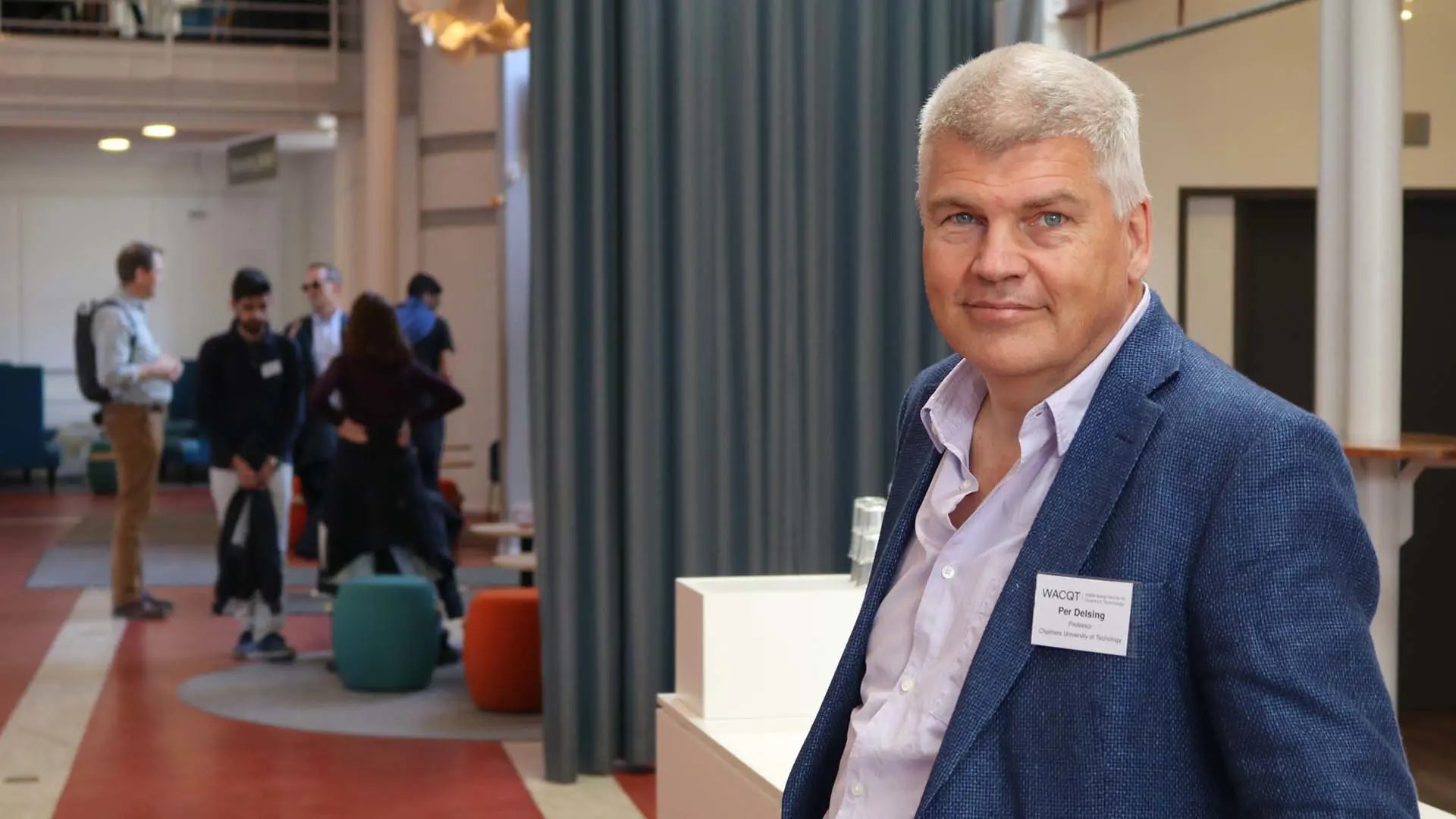
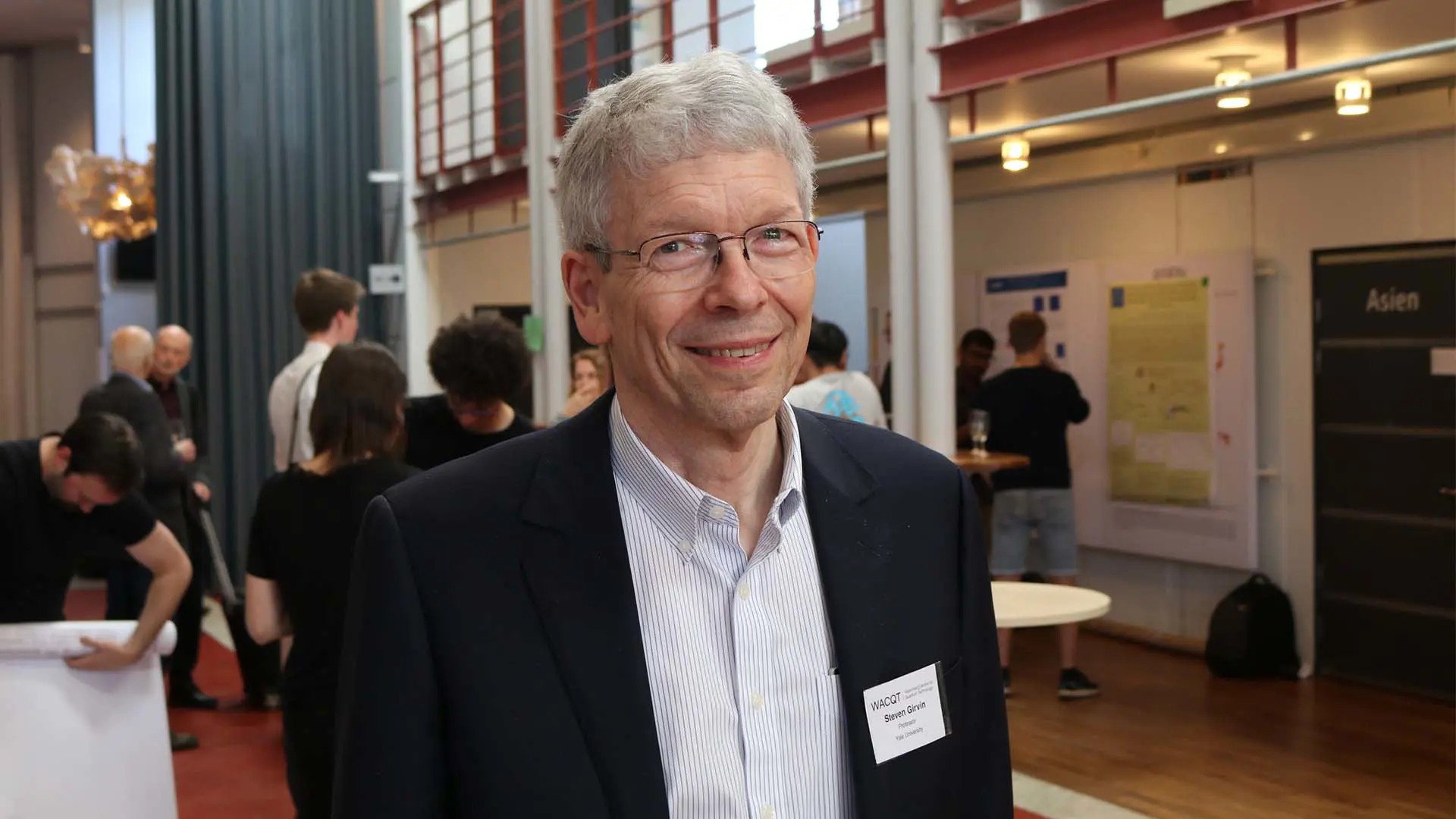
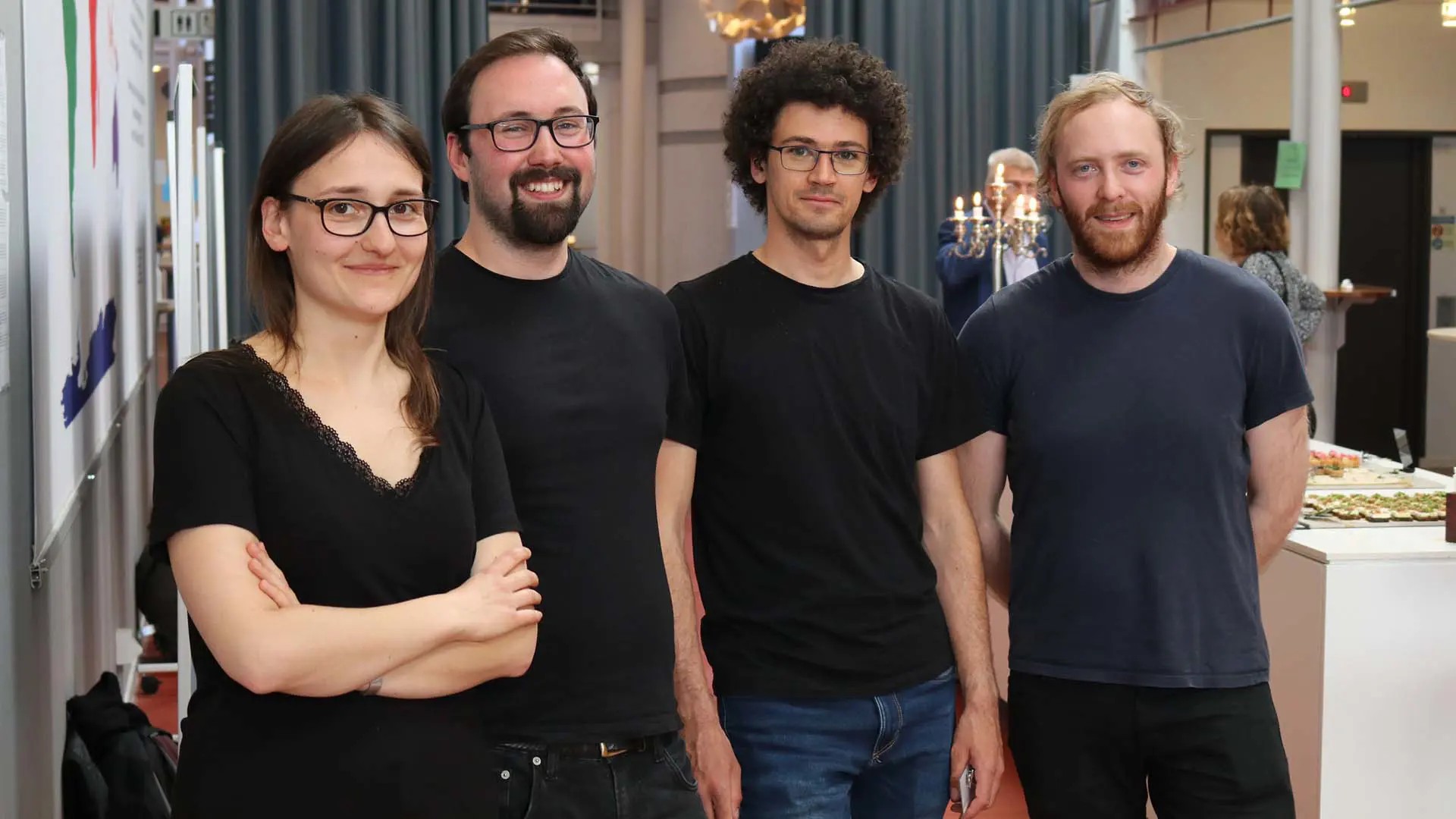
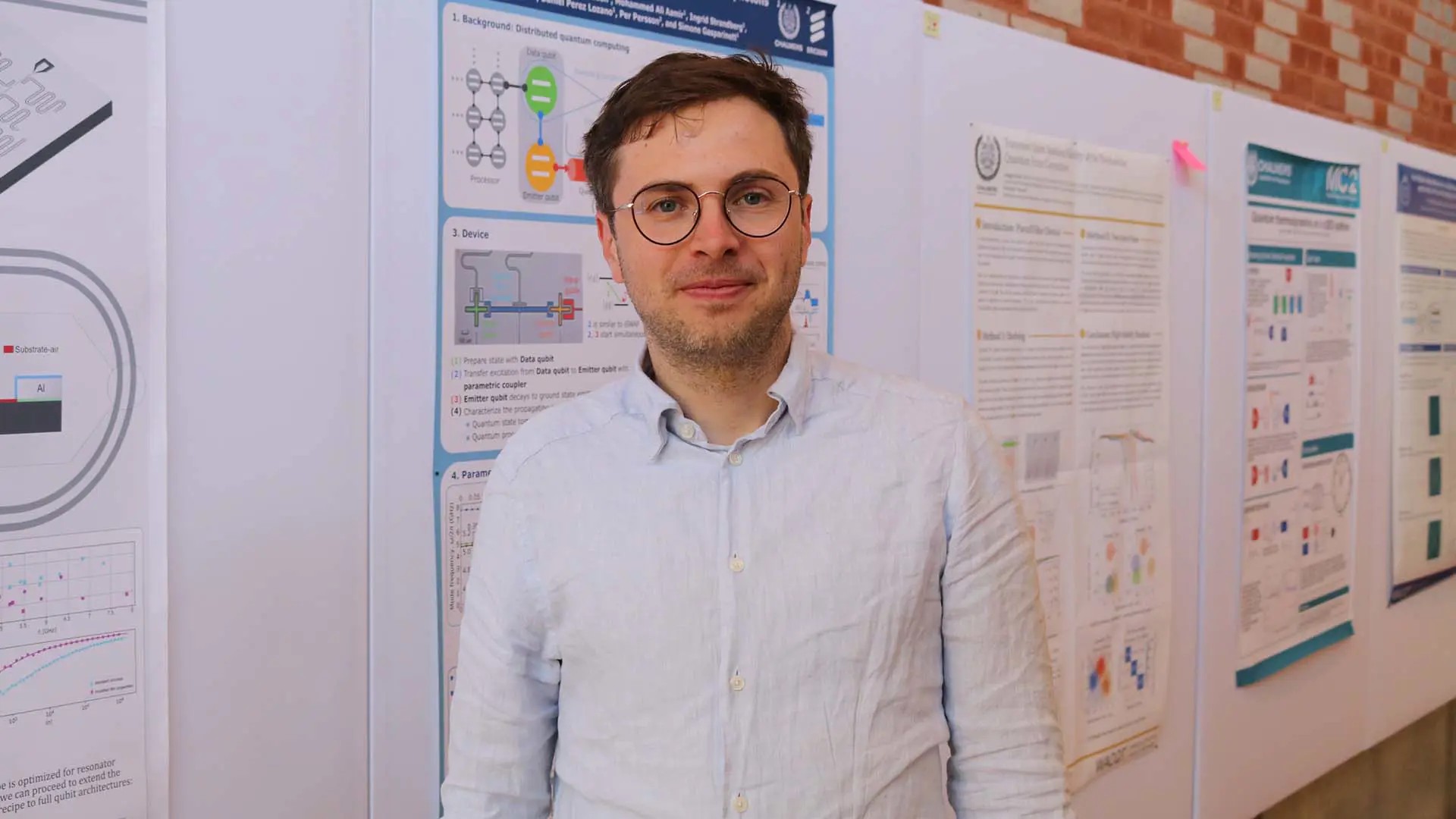
Why do we need a Swedish quantum agenda? How do you best deal with the current quantum hype? And how is the construction of the quantum computer at WACQT coming along? These were a few of the topics that were up for discussion as the PhD students, researchers, partners, advisors, and board members of WACQT met up to review the center's activities during their annual May meeting.
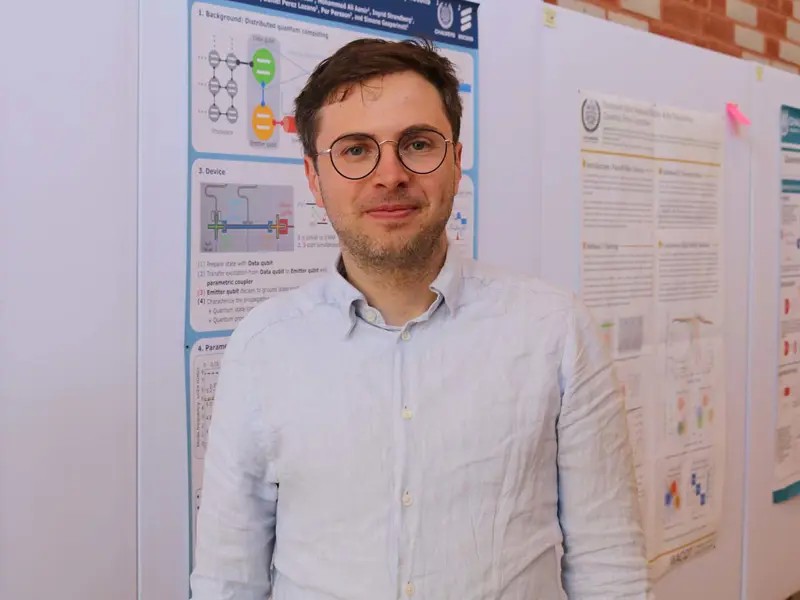
On May 10 – 12, the fourth edition of WACQT's annual May meeting took place. About 130 of the PhD students, post-docs, researchers, partners, and advisors engaged in WACQT were present to take part in the center's development and activities during the past year. A member group that has increased greatly in number since the start in 2018. Subsequently, it has outgrown the premises at Chalmers and this year’s meeting is held at the significantly larger Wallenberg Conference Centre.
The three-day event is packed with poster sessions, lectures on current research projects and overall conversations about WACQT's status and future. In the foyer, in front of one of the many research posters, we find Raphaël van Laer, Assistant Professor of quantum technology at Chalmers University of Technology and one of WACQT's researchers. For him, the May meeting comes with the opportunity for important exchanges - scientific and social - with other researchers within the center.
“It's not often you get the chance to meet everyone within WACQT in this way. For me, it also means that I get to network with other researchers at WACQT, and that is of course extremely valuable,” he says.

A few meters away are some of the 40 PhD students who have had the opportunity to present their research projects and show their posters to their WACQT colleagues.
“It’s nice that we PhD students get the chance to present our projects. This is a good way for everyone to get a good overview of all the research that takes place within WACQT. And I really liked the structure of this year's program,” says Natalia Kuk, PhD student in Trapped Ion Quantum Technologies at Stockholm University.
And Mattias Ammitzböll, PhD student in Atomic Physics at Lund Institute of Technology, agrees.
"I really liked that the sessions were slightly shorter this year, and that by listening to all the PI's presentations of the different focus areas within WACQT, you got to take part of highlights from all the projects,” he says.
The PhD students also agree on sensing a stronger focus on commercialization in the field compared to previous years.
“There has been a lot of talk about start-ups and the business side of quantum technology. I think it would have been interesting to listen to a company that can tell us about what they do in the field,” says Marcus Lindén, industrial PhD student in Atomic Physics at LTH Lund University.
"After all, I’ve been doing research in the field for almost 40 years, and the fact that we can now offer something that can benefit others feels great”

The quantum computer soon up and running
In the crowd we also find Per Delsing, director of WACQT and one of the six original researchers who five years ago applied for the grant that would make WACQT possible. Seeing the number of members go from a handful to the 126 “WACQT:arians” who are in place today is undeniably a sign that the center's development is going in the right direction.
“Of course, it’s a really nice feeling to see that things are moving forward, and to be able to meet everyone in WACQT. We are now almost halfway through the center's funding. We have had a significant ramp-up phase, but now we are in a "steady state",” says Per.
There’s no way to address the status of WACQT without getting into the center's main project: a 25-qubit computer – which will eventually go up to 100 qubits – and that has been under development since the start. If all goes according to plan, it will be fully up and running before the end of the year.
“Now we’re working hard to make it work properly. We’re running some stuff on it now but not all of it works yet. At the same time, our theoreticians are working on a number of problems that we will solve once the computer works. It may deal with air traffic optimization or simulating molecules for catalysts or pharmaceutical development. Or with protein folding, i.e., how you can get proteins to "curl" together, which is important if you for example want to understand certain diseases,” explains Per.
Test bed available within two years
The quantum computer is currently also acting as a model for a quantum computer copy that WACQT will be able to offer as a test bed for external research actors and companies that wish to test algorithm ideas. The test bed is expected to be ready in January 2025 but a customer service unit, the Quantum Helpdesk, will be in place as early as in January 2024, ready to take calls from companies wishing to try out the quantum computer to solve specific challenges. There are similar testbeds in a few places around the world, and IBM is one major player that is currently in the process of building one. But there are aspects in which the projects differ.
“IBM doesn't talk about what they have under the hood, but we do. The difference for the customer is that you can optimize your algorithm if you can see how it works. If you were to drive a Formula 1 car, but don't know if it's electric or how many cylinders it has, you won't win the race,” explains Per.
One of WACQT's major purposes is about making quantum technology available to the world outside the research lab. And in that perspective, the test bed is seen as a success factor.
“It's great that we've come this far and that we have something available that will be useful. After all, I’ve been doing research in the field for almost 40 years, and the fact that we can now offer something that can benefit others feels great,” says Per.
Creating the right expectations in the quantum hype an important task
But next to the technical activities, Per and his colleagues have put a lot of effort into completing the roughly 15-page long document that constitutes Sweden's first quantum agenda. The purpose? To contribute to a national quantum strategy that utilizes the opportunities of quantum technology and ensures that Sweden is at the forefront of the field. For that, concrete goals are needed to secure competence in quantum technology, both through education and research as well as competence development in industry and society. And at the end of March the agenda was finally completed. The presentation of its content to the government took place in two stages. First, a round table conversation at the Royal Swedish Academy of Engineering Sciences (IVA) with, among others, Minister of Education Mats Persson. After that, in-depth talks with the Ministry of Education and several representatives from other ministries.
“They asked very interested questions and we managed to get our message across. Now they must get some time for deliberation on their end. But it’s clear that the government is spending time on this and that it’s considered an important topic. For us, it’s important that politicians don’t build up the wrong expectations of quantum technology. This is a journey that will take a long time. There will be a quantum revolution, but not tomorrow,” says Per.
“I’m amazed of the progress. I never would have predicted we’d come this far. But the distance to the goal is so far away.”

The hype surrounding the potential of quantum technology sure comes with great expectations – but also with some misunderstandings. This becomes especially clear during a presentation held by Robert Rehammar, researcher of quantum technology at WACQT and Chalmers University of Technology. Under the heading "Hope for Quantum Computing?" he highlights a common - and somewhat alarming - reaction he often encounters from investors:
"I don't know much about quantum computers, but they seem really fantastic, and I know that they're really fast."
Robert's point is that quantum technology research is further away from broader commercialization than the general public might realize. A concern shared by Steven Girvin, Professor at the Yale Quantum Institute and chair of WACQT's scientific advisory board.
“This is a problem that I’m really worried about. There’s an amazing growing hype with great capital investments. It’s important to understand that quantum computers have a huge potential but we’re still at an early stage. We don’t have computers as such, we have interesting physical devices, demonstration projects and experiments which are teaching us what we need to learn to build useful computers. And we have to be careful when talking to investors and governments need to be patient and not too focused on the hype. I’m happy to see that WACQT has played an important role in the Swedish Quantum Agenda that was handed over to the government,” says Steven.
Positive view of WACQT's activities from scientific advisory board
With 45 years of research in the field, Steven Girvin is a true protagonist in quantum mechanics. As chairman of WACQT's scientific advisory board, he’s here to review how the research is progressing, how the center supports quantum technological development at large, and what the outreach in society looks like. And of course, how the construction of the quantum computer is coming along.
“It’s enjoyable for the members of the advisory board to hear about the physics and engineering going on in WACQT, and to follow its progress. There are so many research areas being exposed and it’s really interesting to hear about. The core project of building a system at 25 qubit scale is making progress. That’s a pretty big scale and the engineers are really building a complex system here,” he says.
In addition to WACQT and the Yale Quantum Institute, Steven is involved in one of the five national centers for quantum technology in the US, which gives him an almost unique perspective on how WACQT compares. And in that aspect, he wishes to highlight the center's industrial PhD students as a distinguishing factor.
“One thing that is especially impressive is the industrial affiliate program in WACQT. It’s interesting to bring students to real companies with real problems. We can learn about and practice on those problems which is really useful for us. Optimization problems for example which have so many variables and that a lot of money is being spent on. We know some algorithms that could be helpful. Companies and their industrial PHD students learn about quantum, and we learn about what problems to solve. When you give advice, you also learn a lot,” says Steven.
A second quantum revolution is coming – but not tomorrow
In the conversations, we allow ourselves to broaden the scope of the possibilities of quantum technology and go slightly outside the boarders of the three-day meeting. And the subject comes with a paradox, no doubt. Because while the hype can create misunderstandings, the success of quantum technology exceeds all expectations. Or as Steven says:
“I’m amazed of the progress. I never would have predicted we’d come this far. But the distance to the goal is so far away.”
To put it in perspective, Steven reminds us of what is usually called the first quantum revolution, which started 100 years ago and paved the way for the transistor in 1947 and a little over ten years later the laser, and some years after that the atomic clock, which laid the foundation for the GPS. All amazing technological innovations that would fundamentally change society. What was not understood at the time was that quantum mechanics had a great deal more potential. And it is this power that - if unleashed - could pave the way for a second quantum revolution.
“Over the last three decades, we've slowly come to understand that if we build a fully quantum-based machine, there are many more powerful things you can do in computation, communication, and measurement. There is so much more power to unleash with a potential as great as in the first quantum revolution. This is the basis for the second quantum revolution,” says Steven.
And so, to the really big question: When will the revolution arrive?
“In ten years, we will have a much better understanding of how to answer that question,” Steven says and laughs.
“The early applications will be for researchers and their problems. But then the areas of application will become much larger. My guess is more than 10 years away.”
And to make matters even more complex, Per Delsing isn’t even sure we’ll notice it once it’s here.
“In 30 - 40 years, we will regard this as a major upheaval of the entire society. But when the revolution is here, we probably won't notice it. It’s only in retrospect that it becomes clear that there has been a revolution.”